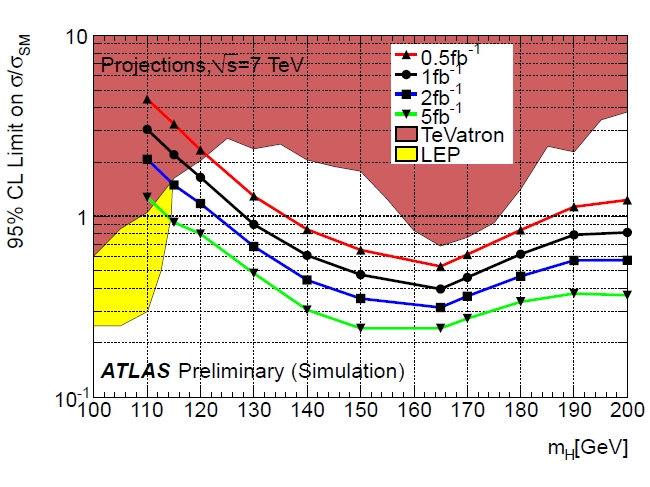The public document is long and detailed, and I have no time to discuss its intricacies with you here, nor do I believe that you would actually want me to. But I do want to discuss one of the most significant figures in the note. It is shown below.

In the figure, you see the 95% confidence-level limit that ATLAS predicts it will extract with one inverse femtobarn worth of proton-proton collisions on the Higgs production rate, in multiples of the Standard Model prediction. This is the variable plotted on the vertical axis: a horizontal line at 1.0 indicates where the SM prediction is, of course, such that when the coloured curves sink below it we can say that ATLAS expects to exclude the Standard Model Higgs for that particular mass value (the value plotted on the horizontal axis). An important thing to note: these limits are expected, at each mass value, if the Higgs boson has a mass significantly different, or if it does not exist. If the Higgs is there, the limit gets worse... until one may claim it is actually there!
Another explanation concerns the brown and yellow areas on the left and on the top of the figure. They display the exclusion already performed at the Tevatron and at LEP II. You are accustomed to see the LEP II limit as a brick wall -a vertical line- but ATLAS took the pain to plot the effective values of the cross section ratios excluded for masses below 114 GeV. Not that this makes much of a difference: if the SM Higgs exists, it cannot have a cross section much smaller than what theorists compute!
Let us return to the new ATLAS results, however. By examining the curves, which are the result of a careful combination of search limits extracted from half a dozen different Higgs decay channels, one gets to see how wide is the exclusion region at ATLAS reach as a function of the integrated data by the experiment. With the 1/fb predicted to be available at the end of 2011, chances are that the lower limit will be around 128 GeV (black curve intersecting the R=1 horizontal line). But with 2/fb the limit already moves down to 122 GeV, and 5/fb allow ATLAS to exclude all the mass values, given that masses below 114 GeV are already ruled out by the LEP II experiments.
It is interesting to note that ATLAS predicts to reach these results single-handedly: the inclusion of similar sensitivity curves by CMS would approximately double the effective luminosity, such that the 1/fb prediction for the lower mass limit on the Standard Model Higgs from a LHC combination corresponds to the 2/fb curve for ATLAS alone, and is probably going to be close to 122 GeV.
And what about a possible first hint of the Higgs ? If the particle exists, a 3-standard deviation evidence may be found by ATLAS: by quoting the paper,
Evidence at the 3-sigma level could be found in a limited range from 1 /fb, but if two experiments like ATLAS were combined there would be a reasonable chance of 3-sigma evidence over most of the mass range from 131 to 430 GeV.Interesting! Maybe we will know where the Higgs sits by the end of next year, after all!
If 2/fb at 8 TeV is collected, and expected or planned analysis improvements are implemented, then the median exclusion region covers a range of Higgs boson masses from 114 to well over 500 GeV.




Comments